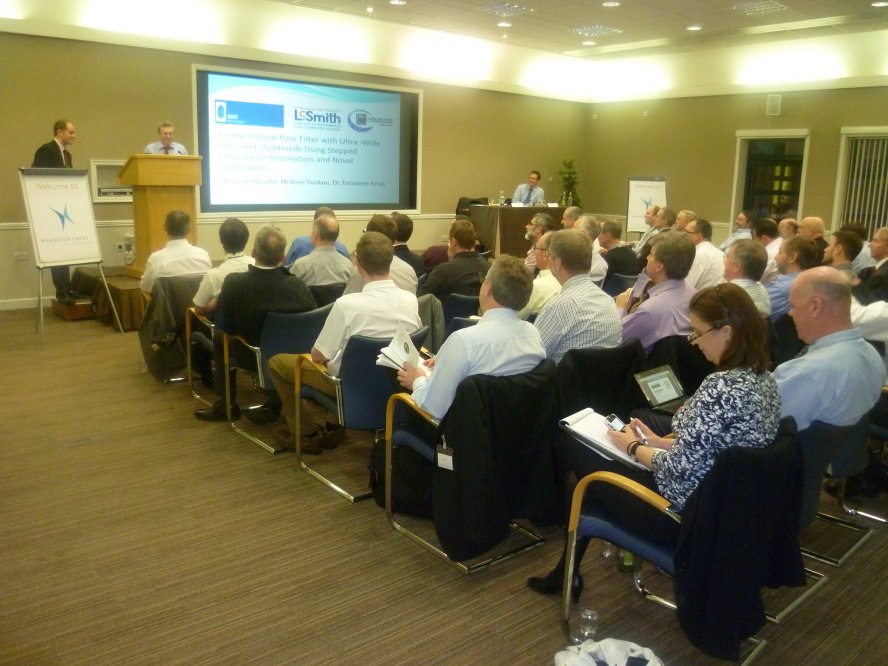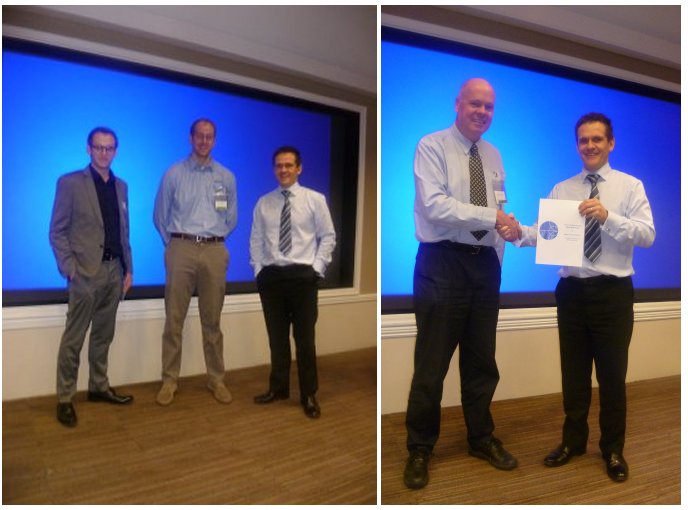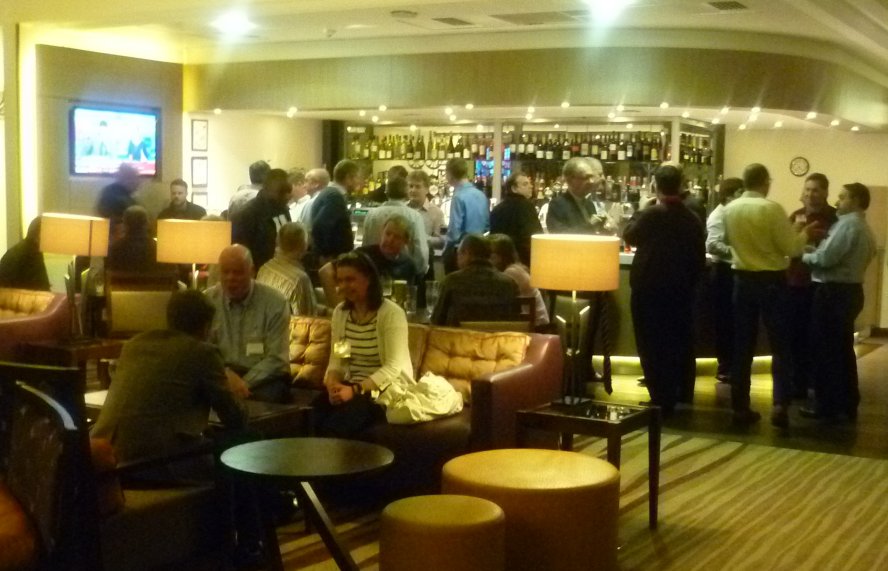This was the Society's first meeting at Wyboston Lakes, situated in a rural location between Cambridge and Bedford. The new venue was very well received by delegates and it is planned to return for the November 2013 meeting. The best paper award was won by Ian Greenshields of Peregrine Semiconductor.
 |  |  |
Wyboston Lakes
Great North Road
Wyboston
Bedfordshire
MK44 3AL
| Tel | 0333 7007 667 |
| sales@wybostonlakes.co.uk. | |
| Web | http://www.wybostonlakes.info/ |
Peter Jupp
Peak RF
A Guide to SMT Packaging of Microwave ICs | |
| Liam Devlin | |
| Plextek Ltd | |
ICs are now available in Surface Mount Technology (SMT) packages at operating frequencies to beyond 40GHz. Whilst the operating frequency and achievable performance of SMT packaged Microwave Monolithic ICs (MMICs) has steadily increased in recent years this does not mean that ICs can be designed in isolation then passed to a packaging facility to be returned with optimum packaged performance. There are many pitfalls that can befall the unwary and probably chief amongst these is to design the IC first and to consider packaging effects only after acceptable RF On Wafer (RFOW) performance has been obtained. This paper discusses the effects of SMT packaging and how to optimise the performance of SMT packaged MMICs. A proven approach to achieving this goal is presented in the form of a case study of a Plextek RFI designed 6 to 18GHz, 0.5W amplifier IC packaged in a conventional over-moulded QFN package. | |
| A Guide to SMT Packaging of Microwave ICs | |
A Novel Architecture Reduces Uncertainties of the Precision RF and Microwave Switched Attenuator | |
| Mark Ashcroft | |
| Fluke Precision Measurement Ltd | |
Scale fidelity or log conformance calibration of high performance spectrum analysers and an increasing demand for linearity verification of power sensors are both strong motivators for reduced uncertainties in attenuation. The achievable performance of a precision RF and microwave switched attenuator is typically compromised by its mismatch, and the source, the load and transmission line mismatch conditions around it. A novel signal levelling and switching architecture has significantly reduced mismatch and its potential impact. This paper presents the new architecture, integrated within a purpose designed RF Reference source and attenuator along with results achieved and quantified benefits at import and export of calibration. | |
| A Novel Architecture Reduces Uncertainties of the Precision RF and Microwave Switched Attenuator | |
A Review of Amplifier Stability Analysis Using Modern EDA Tools | |
| Malcolm Edwards | |
| Applied Wave Research Ltd | |
Modern design tools possess many utilities that can be employed to explore the stability of circuits. These range from invasive techniques such as probes and n port elements which are inserted into the circuit schematic, to non-invasive methods which involve calculation of the circuit matrices, for example K factor calculations and NDF techniques. This paper discusses these methods and will attempt to put the various techniques into perspective so that designers are able to select the most appropriate tool for their circuit. | |
| A Review of Amplifier Stability Analysis Using Modern EDA Tools | |
Advancements in Tunability - Applications beyond the Antenna | |
| Ian Greenshields | |
| Peregrine Semiconductor | |
The increasing complexity and performance requirements of the RF Front End necessitate incorporating means to recover and improve performance for a given air access channel having both fixed and variable environmental parameters. An obvious first application of tunability is the antenna, where decreasing volumetric allowances and the ever present hand and head TRP influences, benefits greatly from real-time, adaptive tuning networks. Scanning beyond antennas, other applications are beginning to benefit tremendously from incorporating methods of real time RF tunability to address challenges such as manufacturing variances, environmental fluctuations, and changing performance needs over a wider range of air access schemes. This paper will provide examples of several of these applications along with the design challenges surrounding each. Examples will include: • real-time amplifier adaptation between constant envelope and complex linear modulation requirements • in-situ tuning on the manufacturing line to compensate for finite production variations • controlled optimization of filter rejection levels | |
| Advancements in Tunability - Applications beyond the Antenna | |
Advances in RFMEMS Capability | |
| Murray Niman | |
| BAE Systems Advanced Technology Centre | |
In contrast to the highly successful market and maturity of MEMS motion sensors (accelerometers and gyros), the RFMEMS market has seen a slow and difficult birth. This paper provides an overview of the challenge and then describes new UK-built highly integrated and packaged RFMEMS. A logical approach that includes wafer-scale packaging has resulted in prototype millimetre-wave Phase Shifters and other switch arrays incorporating up to 40 RFMEMS devices. | |
| Advances in RFMEMS Capability | |
Compact Low Pass Filter with Ultra-Wide Pass and Stopbands Using Stepped Impedance Resonators and Novel Techniques | |
| Luke Murphy, Mohsen Yazdani, and Ercument Arvas | |
| University of Syracuse | |
The design procedure of a compact ultra-wideband (UWB) stepped impedance resonator (SIR) low pass filter (LPF) is presented in this paper. A SIR LPF with 15.5 GHz cut-off frequency miniaturized by meander line technique is designed and it is shown that offsetting the stepped impedance resonators, as well as indenting the tap location greatly improves rejection bandwidth. By cascading multiple filters the passband is increased while maintaining good rejection bandwidth. The proposed filter is simulated in EM software, fabricated, and tested on a high dielectric ceramic. The results show an improved stopband and passband performance compared with similar topologies with a drastic reduction in filter size. | |
| Compact Low Pass Filter with Ultra-Wide Pass and Stopbands Using Stepped Impedance Resonators and Novel Techniques | |
Envelope Amplifier from digits to PA | |
| Gerard Wimpenny | |
| Nujira | |
This talk will cover the 3 major elements of the envelope path; 1) Envelope Processing i.e. pre-processing of the reference signal feeding the envelope amplifier, 2) Envelope Amplifier Design requirements and 3) the interconnection between envelope amplifier and PA. The section on Envelope processing will cover the topic of envelope shaping including the use of envelope shaping for PA linearization and its influence on the bandwidth requirements of the envelope amplifier. Examples of performance achievable from commercial ET amplifiers spanning output powers from 1W to multiple kW will be given. Lastly, the importance of the interconnection between the envelope amplifier and PA and the ramifications for the design of the RF PA will be explained. | |
| Envelope Amplifier from digits to PA | |
High Current TLP Characterization: An Effective Tool for the Development of Semiconductor Devices and ESD Protection Solutions | |
| Werner Simbürger, David Johnsson, Matthias Stecher | |
| High Power Pulse Instruments (HPPI) GmbH | |
The classical Transmission Line Pulse (TLP) system consists of a 50 Ohm high voltage pulse generator, a high speed sampling oscilloscope, a Source Meter Unit (SMU) and a host PC. The typical range of the pulse waveform parameters are: amplitude in the range of up to ±4 kV, output currents up to ±80 A, pulse width in the range of 1 ns up to 1.6 µs, pulse rise time in the range from 100 ps to 50 ns. The transient voltage and currents at the device under test (DUT) are recorded using a high speed sampling oscilloscope with e.g. 12 GHz bandwidth and 40 GS/s sampling rate. Such a measurement system can be used very effectively to investigate transient characteristics of semiconductor devices or circuits in the high voltage and high current time domain, such as: • High current I-V characteristics of devices and circuits in pulsed operation mode: the “TLP-characteristic” • Turn-on/off transient characteristics of the device • Breakdown effects • Charge recovery effects (reverse and forward recovery times of diodes) • Safe Operating Area (SOA) or Wunsch-Bell characteristic • Ruggedness of transistors (RF-LDMOS, DMOS, CMOS, BJT, …) • MOS gate oxide reliability • Packaging and handling ESD (ANSI/ESDA/JEDEC JS-001-2010) • Human-Metal-Model (HMM) and system level ESD (IEC-61000-4-2) This presentation will give an introduction about the basic principle of a high voltage TLP generator and how it can be used effectively for ESD design, general troubleshooting and device characterization. Live demonstrations and measurements of the ESD performance of RF transistors, transient voltage suppressor (TVS) diodes and MMICs will be performed at the HPPI exhibition stand throughout the two-day conference. | |
| High Current TLP Characterization: An Effective Tool for the Development of Semiconductor Devices and ESD Protection Solutions | |
Key Performance Parameters of ESD Protection Devices for High Speed I/O, RF and Monolithic Microwave Integrated Circuits | |
| Thomas Schwingshackl, Andre Schmenn, Damian Sojka et al | |
| Graz University of Technology and Infineon Technologies AG | |
Damage by electrostatic discharge (ESD) is a permanent threat to valuable electronics. Data and audio ports, antennas, keypad, touchscreen as well as displays are exposed to dangerous transients originating from electrostatic discharge either triggered by contact to human beings or any objects carrying electrostatic charge. A well established solution to protect circuitry from these destructive ESD events is to shunt most of the ESD pulse energy by transient voltage suppressor (TVS) diodes thereby reducing the residual transferred energy to the protected device to a minimum. However, using advanced semiconductor technologies the ESD susceptibility of ICs are subsequently getting higher. By the same time, data rates of I/O ports are increasing, reaching far into the GHz regime. A challenge for the protection device design is to balance both, superior protection characteristics as well as minimum impact to the nominal function of the circuitry, i.e. maintaining highest signal integrity. In a short introduction we’ll show electrostatic discharge is a specific, but well determined operating condition of integrated microelectronics, characterized by fast transients and high power, thus requiring specific measurement techniques. In this field transmission line pulse techniques have established as a versatile tool for characterization of protection devices, but moreover for the systematic development of ESD solutions. In the main part of the paper key performance parameters of state-of the art protection devices are evaluated and application examples are shown. It will be demonstrated that a fair trade-off between ESD capability, signal integrity i.e. device capacitance, harmonic distortion as well as transient characteristics must be made. For high speed interface protection, this challenge has been met by subsequent improvements in design and technology, i.e. topologies combining low signal coupling with highest energy absorption capability. Beside the silicon chip the package plays a crucial role in terms of parasitics, influencing the overall device performance. As a result we demonstrate a protection device with only 100 fF capacitance and ±15 V breakdown voltage, which sets the industry’s standard for low capacitance protection devices. While this device is designated for applications in antenna protection, a low voltage version addresses highest data-rate interfaces, ie. Thunderbolt. | |
| Key Performance Parameters of ESD Protection Devices for High Speed I/O, RF and Monolithic Microwave Integrated Circuits | |
Novel infra-red (IR) thermal measurements on GaAs micro-coolers | |
| James Glover, Richard Hopper, Ata Khalid et al | |
| De Montfort University, University of Glasgow, University of Bristol and University of Aberdeen | |
Electronic devices are shrinking in size and new materials such as gallium nitride (GaN) are being introduced, resulting in higher dissipated power densities. Therefore, new and novel technologies are required to remove the heat and to thermally characterise the devices. A particular example of a device that will require these thermal management technologies is the gallium arsenide (GaAs) planar Gunn diode which is being developed for millimetre-wave and terahertz (THz) frequencies, and in which the dissipated power density will be very high (approximately 106 W/cm2). This paper will review preliminary thermal and electrical characterisation of a GaAs electro-thermal micro-cooler with the aim of its integration with the planar Gunn diodes, thus increasing the efficiency of the latter. The thermal characterisation of these electro-thermo coolers brings its own set of unique measurement problems. A comparative temperature measurement has been developed using infra-red (IR) thermal microscopy and novel micro-particle sensors. The measurement technique will be described in detail and preliminary measurements on simple superlattice electro-thermal GaAs micro-coolers will be presented. | |
| Novel infra-red (IR) thermal measurements on GaAs micro-coolers | |
Origins of the Magnetron | |
| Rod Burman | |
| - | |
The Resonant Cavity Magnetron structure was investigated by scientists in a number of different countries around 1940, but it is generally accepted that John Randall and Harry Boot from Birmingham University developed a practical design for the generation of high power pulses making centimeter-band radar feasible. The compact cavity magnetron tube drastically reduced the size of radar sets so that they could be installed in anti-submarine aircraft and escort ships. | |
| Origins of the Magnetron | |
Phase Locking Techniques Adaptable for a Range of RF Microwave Sources | |
| Richard Jenkins | |
| SMS Ltd | |
The use of programmable frequency synthesisers enables the flexibility of adapting a pre-made phase-locked loop (PLL) circuit to control a wide range of microwave sources, e.g. voltage controlled oscillators (VCOs), dielectric resonance oscillators (DROs). This flexibility greatly reduces the cost and time of production and maintenance compared to the conventional method of using discrete components (e.g. frequency detector, divider etc.). This paper discusses the methodology for the design and production of a microwave VCO and the phase locking circuit that can be adapted to frequency synthesise the VCO. Hybrid chip and wire technology on an Alumina substrate was used for the VCO and surface-mount technology (SMT) for the phase-locked loop. The computational modelling and design was carried out with AWR Microwave Office. Programming the phase locking circuit enables the output frequency (or frequencies) to be precisely locked within the frequency range of the VCO or multiples of the VCO’s frequency. This serial information is then programmed on a memory chip to enable automated operation when the unit is powered up. Whilst reducing production time and cost, this approach, achieves synthesised frequency sources up to and beyond 20GHz with competitive phase noise (e.g. 100dBc @100kHz offset), suitable for either commercial or military applications. | |
| Phase Locking Techniques Adaptable for a Range of RF Microwave Sources | |
Step-recovery diode phase-standard characterisation and preliminary structure-based covariance compression algorith | |
| Matthew Harper | |
| National Physical Laboratory | |
The traceability route for phase-standards is outlined together with a preliminary compression algorithm that allows the uncertainties, represented as a covariance matrix, to be efficiently stored so that they may be represented in either the time or frequency domains The final algorithm will be available on the Euramet IND016 website | |
| Step-recovery diode phase-standard characterisation and preliminary structure-based covariance compression algorith | |
Using active load pull to realise harmonic efficiency enhancement in MMIC amplifiers | |
| Dominic FitzPatrick | |
| PoweRFul Microwave | |
This presentation will outline the importance of including harmonic load pull in the characterisation of transistors and the benefits of integrating measurement – simulation and design in a single environment. The design of a 5-10GHz 0.5W driver stage MMIC demonstrating the methodology will be outlined. | |
| Using active load pull to realise harmonic efficiency enhancement in MMIC amplifiers | |
Vector Signal Analysis - 20 years on | |
| Tim Masson | |
| Agilent Technologies | |
Vector Signal Analysis techniques have been used since the early 1990’s for capture and analysis of digitally modulated signals and for hard to analyse phenomena, such as synthesizer frequency and amplitude transients. Today VSA measurements are used in many different instruments and for many different applications. In this paper we look at how measurement techniques have progressed from analog methods of detection to digital signal processing and at some of the benefits, in terms of speed and accuracy that have come from these changes. | |
| Vector Signal Analysis - 20 years on | |
As usual there was a successful supporting exhibition. Any companies interested in exhibiting at future meetings should email exhibition@armms.org
Contributions are invited with an emphasis on RF and microwave design, research, testing and associated subjects. An oral presentation will be made at the meeting and a written paper will be required for publication in the society digest, which is distributed to delegates at the meeting. Prospective speakers are requested to submit a title and a short abstract to the technical coordinator (see above) as soon as possible.
Click here to view our Guidelines for Authors
Click here to view our Publication Release Form